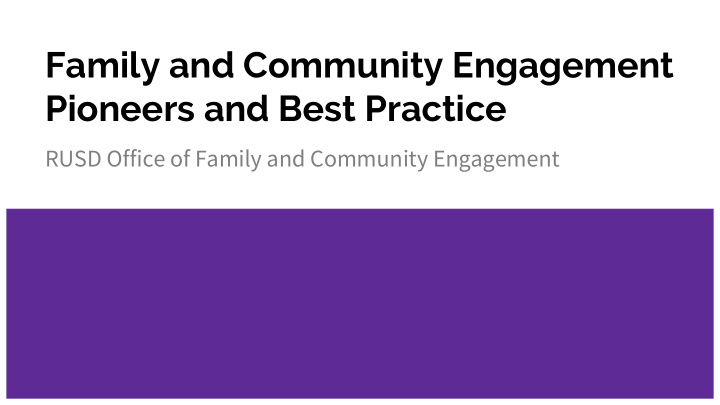



Family and Community Engagement Pioneers and Best Practice RUSD Office of Family and Community Engagement
Overview Welcome and Icebreaker Activity ● Family and community engagement overview ● Family and community engagement research and best practices ● The Office of Family and Community Engagement ● Next Steps ●
Welcome and Icebreaker Welcome ● Introductions ● Icebreaker ●
Icebreaker Questions- Roll The Dice 1. If you could be any place in the world right now, where would you like to be? 2. If you were not a ______, Today, what would be your career choice? 3. How many members are there in your immediate family? 4. What are you most grateful for? 5. What can’t you live without? 6. As a parent, what is the one funny thing that you do that you never imagined came with being a parent?
FACE Overview Family and community engagement (FACE) is defined as “a reciprocal partnership ● between parents and programs that reflects a shared responsibility to foster young children’s development and learning”. (Forry, Moodie, Rothenberg, & Simkin, 2011) FACE comprises of parents (broadly defined to refer to a primary caregiver) and ● school staff, social service providers and community members Works together to actively support and improve the academic achievement, social ● and behavioral development, and health of children, adolescents and young adults
Defining Engagement Engagement extends beyond simple involvement by empowering families to ● recognize their own needs, strengths and resources and take an active role in making change Engagement vs. Involvement ● Involvement: Ideas and energy tends to come from schools and from government mandates ○ Parent is directed towards completing tasks selected by school staff ■ Engagement: Ideas tend to be elicited from parents by school staff in the context of developing ○ trusting relationships Parent is considered a leader or potential leader who is integral to identifying vision/goals ■
FACE Research and Best Practices Karen Mapp, Harvard Graduate School of ● Education Consulted with the US Department of ○ Education to create the Dual Capacity-Building Framework for Family School Partnerships https://www.gse.harvard.edu/news/u ■ k/14/11/building-capacity-family-enga gement See handout ■ Joyce Epstein’s Framework of Six Types of ● Engagement See handout ○
Title 1 Parent Engagement Federally-funded program ● It is not a special education program. ● In Racine County, it focuses on reading and math from K3-9th grade. ● For RUSD or non-public schools to qualify they must have a students population of ● 64.8% or higher of student population that qualifies for free or reduced lunch. Qualifying schools gets additional funds for ( *All funds must be related to reading and math ) : ● Staff ○ Professional development ○ Materials for classroom instruction ○ Parent involvement ○
Office of Family and Community Engagement Mission/Vision/Values ● Initiatives ● Title 1 updates ● Planning and Next Steps ●
RUSD FACE Survey Results ● I n Spring of 2016 FACE administered a survey to RUSD staff who were in the following positions: Teachers ○ Social worker/Counselor/Psychologist ○ School Administrator ○ Others ○ Results of the survey helped FACE determine what areas to focus on: ● 60% of respondents said that the district and the schools perform average or below average on ○ family engagement Communication, Relationships and Collaboration were identified as key components needed in ○ effective family engagement Identified obstacles: communication, lack of resources, school climate ○ Areas of support needed: resources, district climate, communication ○
Call to action and next steps What you can do? ● Begin to identify fellow/potential parent leaders ○ Build relationships ■ Invite to events ■ Explore starting/joining a parent group in your school ■ Parent Leadership Network (PLN) ○ Who we are and where do we want to go? ■ Relational meeting assignment ■ Next Steps for the Office of FACE ● Strategic planning ○ Upcoming events ○
Thank You!!!
Recommend
More recommend